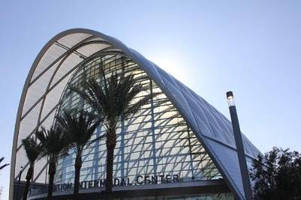Ethylene Tetrafluoroethylene (ETFE)
Come See Vector Foiltec's Texlon® ETFE Enclosure at the Anaheim Regional Transportation Intermodal Center (ARTIC)
Share:

COHOES, N.Y. –Â The Anaheim Regional Transportation Intermodal Center (ARTIC) is an iconic gateway to a new era of transportation options. ARTIC, the striking, arched transportation hub that opened to the public on December 6, 2014 in Anaheim, fulfils Orange County and the City of Anaheim's vision to encourage the use of public transportation, simultaneously alleviating highway congestion.
ARTIC sits in a pedestrian zone in central Anaheim and supports area-wide public transport and regional travel connections of all types, from bikes to bus and rail. "Inspiration came from great transport terminals like Grand Central Station, but ARTIC is one of a kind and iconic in terms of its vaulted shape," said Kazem Toossi, project architect and Senior Principal at HOK. "The interdisciplinary teams of Parsons Brinckerhoff and HOK created the most efficient parabolic shell, based on a torus."
This busy thoroughfare, with its retail outlets and restaurants, plus Wi-Fi and charging stations, is set to positively transform the travel experience for thousands of commuters each day. Two parabolic, operable glass walls at the north and south ends, together with the curved translucent Texlon® ETFE roof, engineered and installed by Vector Foiltec, open the building up to the benign Californian climate.
"The city had the vision some years ago to create a building that will attract the attention of its residents throughout the region to the public transportation network," said Christopher Marcotte, Project Manager for Vector Foiltec, the company behind the Texlon® ETFE brand.
Passengers enter from the north, accessing bus bays and bike lockers from the main lobby. They can ascend stairs or an escalator to a second floor of restaurants lit by natural light, but protected from the heat by the Texlon® ETFE roof. The third floor provides seating on the way to the train platforms.
"We went through different materials and ETFE proved the most appropriate and flexible for the long span. Its lightness allowed the dia-grid to be made from steel tubes of the minimum diameter," explained Toossi. "The low embodied energy helps make this the first LEED Platinum transit station in the world. In operation, the building uses 30-50% less energy by exploiting natural ventilation and heating and cooling elements in the floor. Photovoltaics on the parking structure provide 20% of the energy required."
"Our multidisciplinary approach addressed design, fabrication and construction," explained Marcotte.
The Texlon® cladding incorporates a frit that allows for generous light transmission into the building, while maintaining optimal solar control and perfect ambient temperatures. The architect added LED lights below the ETFE to accentuate the diamond shape of the panels, making ARTIC equally recognisable and iconic at night.
Vector Foiltec invented ETFE (Ethylene-Tetra-Fluoro-Ethylene) cladding technology and is the global market-leading specialist. Today, the company manufactures its product under the trademark of Texlon® and operates two high-capacity production facilities. In addition to holding the world's most comprehensive body of related research data, Vector Foiltec also continues to bring further technical innovation to the construction industry.
Project details
Contract architect: Parsons Brinckerhoff
Design architect: HOK
General contractor: Clark Construction Group
Roof system: Vector Foiltec
Steel fabrication: Beck Steel
Structural engineer: Thornton Tomasetti
Mechanical, electrical, plumbing engineer: BuroHappold North America
ETFE Area: 58,600 sq.ft.
Height: 120 ft.
Media contact: Christina Borecki, 1-518-783-0575, christina.borecki@vector-foiltec.com
Jocelyn O'Shea, +44-208-821-2932, jocelyn.oshea@vector-foiltec.com.
SOURCE Vector Foiltec




